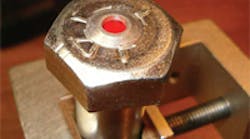An innovation in bolt indicators ends the guessing game for obtaining an optimum bolt preload.
There are many applications in which it is crucial that a proper bolt preload should be applied and, usually, these applications involve critical safety and reliability issues.
A company that designs and fabricates flight simulators for commercial and military aircraft personnel training found a solution to obtaining and monitoring optimum bolt clamp load in the form of an innovative bolt that contains a Direct Tension Indicator (DTI).
The senior mechanical engineer for the flight simulator company said torque wrenches are not always an accurate means to measure preload because friction and other factors have to be overcome. Additionally, he noted, his company’s hardware had bolts mounted in locations that are difficult to access.
The company found a solution in the form of DTI SmartBolts, a product invented and developed by Stress Indicators of Bethesda, Md., (www.smartbolts.com).
The company’s innovative bolts contain a visual indicator that changes color when the optimum preload is reached.
Before tightening, the bolt is bright red. When it reaches the specified preload, the indicator becomes black. The color change indicates that the bolt is at its correct tensile state when first torqued, and it can be inspected thereafter and can be replaced or tightened if it becomes loose.
The flight simulator company has strict hardware torque requirements that combine to make it an accurate replication of the operation and sensation of an operating aircraft. Simulators must meet strict Federal Aviation Administration requirements to be used for pilot training.
Further, because simulators cost less to operate than aircraft, they also are used to keep pilots’ airtime up both in commercial and military applications, and are used for military mission training so that a pilot will be familiar with the flight of a mission before it takes place.
So, getting and maintaining accurate preloads of the bolts within simulators’ motion systems is vital.
SmartBolts ensure that accurate preloads are maintained and can be verified within the simulators. Additionally, the bolts can be monitored after the simulator is shipped.
Chuck Popenoe, technical director for Stress Indicators, developed the idea for the SmartBolt when he began to look for a better way to accurately gauge bolt preloads than torque wrenches.
Charles Popenoe, Chuck Popenoe’s son and president of Stress Indicators, said there are always issues with using torque to measure the actual tension on a bolt.
“The tension is what matters, it’s what holds the joint together, but the torque is about the only way to measure without fancy gauges and instruments. But with the torque, you still have to overcome all the friction, then try and separate that out from the tension,” Charles Popenoe said.
The SmartBolt measures only the actual tension on the fastener, he added.
Applications that can benefit from the bolt are any in which its critical that the proper preload be applied and continually verified, including those that involve safety and liability factors, such as manufacturing equipment, presses and rolling equipment, and heavy construction vehicles.
Stress Indicators said that the General Electric Co. uses the bolts to ensure that electrical buss joints — a static application — have the proper tension to avoid heat buildup or loss of current.
An additional benefit comes to facilities that may not even possess equipment such as torque wrenches to check or even install the bolts. SmartBolts can be applied with ordinary wrenches, and can then be visually inspected thereafter.
This article was written by Bruce Boyers a freelance writer based in Glendale, Ca., for Stress Indicators, Inc., and edited by Bruce Vernyi, Editor-in-Chief of American Machinist.








